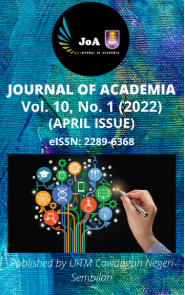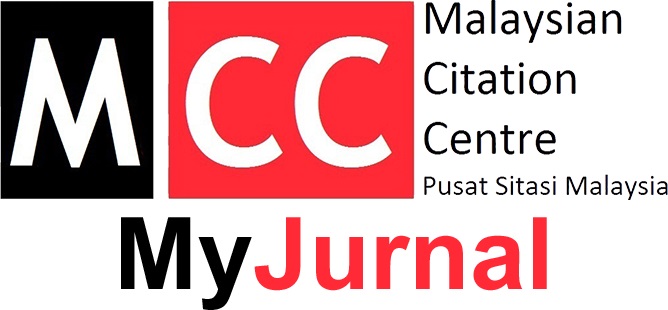SYNTHESIS, CHARACTERIZATION AND CORROSION INHIBITION SCREENING OF Co(II) DITHIOCARBAMATE COMPLEXES:Co[BuMedtc]2 AND Co[EtBenzdtc]2
Keywords:
Dithiocarbamate, Corrosion, HCl, H2SO4, Weight LossAbstract
Mild steel is a type of carbon steel with quite a low carbon content, or particularly known as plain-carbon steel. It is often used as a construction material because of its relatively low price. However, unlike stainless steel, it has low corrosion resistance, therefore some form of protective film should be applied to prevent it from rusting in corrosive environment. The inhibiting action of the synthesized dithiocarbamates (DTC), namely, Co(II) N-butylmethyldithiocarbamate, Co[BuMedtc]2 and Co(II) N-ethylbenzyldithiocarbamate, Co[EtBenzdtc]2 towards the corrosion behavior of mild steel in acidic solution was studied. The proposed structures of complexes were characterized by using Fourier transform infrared (FTIR), ultraviolet-visible (UV-Vis), gravimetric analysis, molar conductivity, and melting point measurement. The analyses data deduced that the DTC ligands have successfully coordinated to Co(II) ion in a bidentate manner. The corrosion inhibition study showed that Co[BuMedtc]2 was a better corrosion inhibitor as compared to Co[EtBenzdtc]2 because this is most likely due to the presence of a less bulky alkyl substituent (-CH3) in Cu[BuMedtc]2 and hence, showing great corrosion inhibition performance. Besides, the shorter the alkyl chain length in Cu[BuMedtc]2, the higher the solubility of the complex in the acid medium. The complexes showed better effectiveness in hydrochloric acid (HCl) rather than sulphuric acid (H2SO4) solution. The corrosion happened more actively in HCl than H2SO4 due to the chloride ions showing more destructive effect than sulfate ion on the carburized low carbon steel samples. In addition, when the concentration of inhibitor increases, the corrosion rate will decrease.
References
Aiad, I., & Negm, N. A. (2009). Some corrosion inhibitors based on Schiff base surfactants for mild steel equipments some corrosion inhibitors based on Schiff base surfactants for mild steel equipments. Journal of Dispersion Science and Technology, 30(8), 1142–1147.
Ajeel, S. A., Waadulah, H. M., & Sultan, D. A. (2012). Effects of H2SO4 and HCl concentration on the corrosion resistance of protected low carbon steel. Al-Rafidain Engineering, 20(6), 70–76.
Ali, I., Wani, W. A., Saleem, K., & Hseih, M. (2013). Design and synthesis of thalidomide based dithiocarbamate Cu(II), Ni(II) and Ru(III) complexes as anticancer agents. Polyhedron, 56, 134–143.
Andreani, S., Znini, M., Majidi, L., Hammouti, B., Costa, J., & Muselli, A (2016). Study of corrosion inhibition for mild steel in hydrochloric acid solution by Limbarda crithmoides (L.) essential oil of corsica. Journal of Materials and Environmental Science, 7(1), 187-195.
Aslam, J., Aslam, R., Alrefaee, S. H., Mobin, M., Aslam, A., Parveen, M., & Mustansar Hussain, C. (2020). Gravimetric, electrochemical, and morphological studies of an isoxazole derivative as corrosion inhibitor for mild steel in 1M HCl. Arabian Journal of Chemistry, 13(11), 7744–7758.
Aslam, R., Serdaroglu, G., Zehra, S., Kumar Verma, D., Aslam, J., Guo, L., Verma, C., Ebenso, E. E., & Quraishi, M. A. (2022). Corrosion inhibition of steel using different families of organic compounds: Past and present progress. Journal of Molecular Liquids, 348, 1–29.
Awang, N., Baba, I., Mohd Yousof, N. S. A., & Kamaludin, N. F. (2010). Synthesis and characterization of organotin(IV) N-benzyl-N-isopropyldithiocarbamate compounds: Cytotoxic assay on human hepatocarcinoma cells (HepG2). American Journal of Applied Sciences, 7(8), 1047–1052.
Blagus, A., & Kaitner, B. (2010). Schiff base in the Cambridge Structural Database (CSD). Macedonian Journal of Chemistry and Chemical Engineering, 29(2), 117–138.
Brown, D. A., Glass, W. K., & Burke, M. A. (1976). The general use of IR spectral criteria in discussions of the bonding and structure of metal dithiocarbamates. Spectrochimica Acta Part A: Molecular Spectroscopy, 32(1), 145–147.
Chigondo, M., & Chigondo, F. (2016). Recent natural corrosion inhibitors for mild steel : An overview. Journal of Chemistry, 2016.
Daoud, D., Douadi, T., Hamani, H., Chafaa, S., & Al-Noaimi, M. (2015). Corrosion inhibition of mild steel by two new S-heterocyclic compounds in 1 M HCl : Experimental and computational study. Corrosion Science, 94, 21-37.
Hashim, N. Z., Kahar, M. A., Kassim, K., Embong, Z., & Anouar, E. H. (2020). Experimental and theoretical studies of azomethines derived from benzylamine as corrosion inhibitors of mild steel in 1 M HCl. Journal of Molecular Structure, 1222(2020), 1–13.
Hazani, N. N., Dzulkifli, N. N., Ghazali, S. A. I. S. M., Mohd, Y., Farina, Y., & Ngatiman, F. (2018). Synthesis, characterization and effect of temperature on corrosion inhibition by thiosemicarbazone derivatives and its tin (IV) complexes. Malaysian Journal of Analytical Sciences, 22(5), 758–767.
Hogarth, G. (2012). Metal-dithiocarbamate complexes : Chemistry and biological activity. Mini-Reviews in Medicinal Chemistry, 12, 1202–1215.
Junaedi, S., Al-Amiery, A., Kadihum, A., Kadhum, A., & Mohamad, A. (2013). Inhibition effects of a synthesized novel 4-aminoantipyrine derivative on the corrosion of mild steel in hydrochloric acid solution together with quantum chemical studies. International Journal of Molecular Sciences, 14(6), 915–928.
Jyothi, N. R., & Farook, N. A. M. (2019). Synthesis and characterization of newly synthesized thiosemicarbazone ligands with IR, NMR and mass spectral techniques. Oriental Journal of Chemistry, 35(1), 43–47.
Khitrich, N. V, Vlasenko, V. G., Seifullina, I. I., & Zubavichus, Y. V. (2014). Local surrounding of Cobalt (II) in dithiocarbamate complexes, their magnetic and spectral properties. Russian Journal of General Chemistry, 84(3), 555–561.
Latif, H., Ahmad, S., Sheikh, I., Ghazali, M., Abdullah, E. N., Lahuri, A. H., Ngatiman, M. F., & Dzulkifli, N. N. (2018). Synthesis, structural, density functional theory , and x-ray diffraction study of Zn (II) N-isopropylbenzyldithiocarbamate : Anti-corrosion screening in acid media. Indonesian Journal of Chemistry, 18(4), 755–765.
Li, F., Bai, M., Wei, S., Jin, S., & Shen, W. (2019). Multidimension insight involving experimental and in silico investigation into the corrosion inhibition of N, N dibenzyl dithiocarbamate acid on copper in sulfuric acid solution. Industrial & Engineering Chemistry Research, 58, 7166–7178.
Loto, R. T. (2018). Surface coverage and corrosion inhibition effect of Rosmarinus officinalis and zinc oxide on the electrochemical performance of low carbon steel in dilute acid solutions. Results in Physics, 8, 172-179.
Mahmoud, W. A., Ali, Z. M. H., & W., R. (2020). Synthesis and spectral analysis of some metal complexes with mixed mixed Schiff base ligands 1- [2- (2-hydroxybenzylideneamino)ethyl]pyrrolidine-2,5-dione (HL1) and (2-hydroxybenzalidine)glycine (HL2). Journal of Physics: Conference Series.
Mamba, S. M., Mishra, A. K., Mamba, B. B., Njobeh, P. B., Dutton, M. F., & Fosso-Kankeu, E. (2010). Spectral, thermal and in vitro antimicrobial studies of cyclohexylamine-N-dithiocarbamate transition metal complexes. Spectrochimica Acta - Part A: Molecular and Biomolecular Spectroscopy, 77(3), 579–587.
Nadira, N., Mohd, Y., Ahmad, S., Sheikh, I., & Ghazali, M. (2019). Electrochemical studies of thiosemicarbazone derivatives and its tin (IV) complex as corrosion inhibitor for mild steel in 1 M hydrochloric acid. Chemistry Journal of Moldova, 14(1), 98–106.
Odularu, A. T., & Ajibade, P. A. (2019). Dithiocarbamates : Challenges, control, and approaches to excellent yield , characterization , and their biological applications. Bioinorganic Chemistry and Applications, 2019, 15.
Othman, N. F. H., Latif, N. S. H., Ghazali, S. A. I. S. M. Abdullah, E. N., & Dzulkifli, N. N. (2021). Ni(II) Butylmethyldithiocarbamate: PhysicoChemical Properties, X-Ray Crystallography, DFT and Anti-Corrosion Screening in Different Acids. ASM Science Journal, 16, 1-11.
Ouakki, M., Galai, M., Rbaa, M., Abousalem, A. S., Lakhrissi, B., & Cherkaoui, M. (2019). Quantum chemical and experimental evaluation of the inhibitory action of two imidazole derivatives on mild steel corrosion in sulphuric acid medium. Heliyon, 5, e02759.
Quraishi, M. A., Sardar, N., & Ali, H. (2002). A study of some new acidizing inhibitors on corrosion of N-80 alloy in 15 % boiling hydrochloric acid. Corrosion Science, 58(4), 317–321.
Shahzadi, S., Ali, S., Wurst, K., & Najam-ul-haq, M. (2007). Synthesis of stannic (IV) complexes : Their structural elucidation in solid and solution state and antimicrobial activity. Heteroatom Chemistry, 18(6), 664–674.
Shetty, P. (2019). Schiff bases : An overview of their corrosion inhibition activity in acid media against mild steel against mild steel. Chemical Engineering Communications, 0(0), 1–45.
Sivasekar, S., Ramalingam, K., & Rizzoli, C. (2015). Metal dithiocarbamate precursors for the preparation of a binary sulfide and a pyrochlore : Synthesis, structure, continuous shape measure and bond valence sum analysis of antimony (III) dithiocarbamates. Polyhedron, 85, 598–606.
Sanni, O., Fayomi, O., & Popoola, A. (2019). Eco-friendly inhibitors for corrosion protection of stainless steel: An overview. Journal of Physics: Conference Series, 1378(4), 42-47.
Sastri, V. S. (2014). Types of corrosion inhibitor for managing corrosion in underground pipelines. in underground pipeline corrosion: Detection, analysis and prevention. Woodhead Publishing Limited: pp. 166–211.
Sonia, A. S., & Bhaskaran, R. (2017). Tris dithiocarbamate of Co(III) complexes: Synthesis, characterization, thermal decomposition studies and experimental and theoretical studies on their crystal structures. Journal of Molecular Structure, 1134, 416–425.
Yuan, Q., Cheng, R., Zou, S., Ding, C., Liu, H., Wang, Y., Yang, D., Xiao, X., Jiang, Q., Tang, R., & Chen, J. (2020). Isatin thiosemicarbazone derivatives as inhibitors against corrosion of AA6060 aluminium alloy in acidic chloride medium: substituent effects. Integrative Medicine Research, 9(5), 11935–11947.
Downloads
Published
Issue
Section
License
Copyright (c) 2022 Journal of Academia

This work is licensed under a Creative Commons Attribution-NonCommercial-NoDerivatives 4.0 International License.












